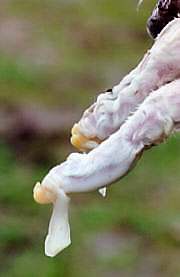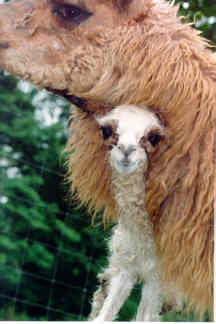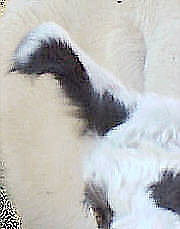|
Home
Herd
Sires
Dams
For
Sale
Cappy's
Place
About
Llamas
Vet
Corner
Barnyard
Hints
Fun
& Games
Over The
Fence
Llama Talk
Youth
& 4-H
Events
Links
Books
Contact
All
American
Youth
Jamboree
|
|
A llama's full gestation is 11 1/2 months or around 350 days. Up to two to three weeks prior to the due date, you may notice signs of the coming delivery with the development of mom's udder, swelling and elongation of the vulva, and also the mom choosing to lay off by herself away from her
herdmates. As the Mom starts into labor, you will notice her visiting the dung pile often with no results, possibly rolling onto her side, and getting up and down frequently. It may be as long as a couple of hours from this time before you see the first presentation of the baby - called a
cria.
|
The first thing you should see is the presentation of the nose closely followed by the two front legs. The head and neck follow with the contractions. Once the shoulders are through, the hardest part of the delivery, the body and back legs will follow quickly. Delivery is normally from a standing position and the cria will fall to the ground. Wet and covered with a thin membrane, you will want to check and see if the membrane is cleared away from the nose and mouth to allow breathing. Baby will quickly start to thrash around and get in a sternal position. Mom does not dry or lick her baby clean so in cool weather you'll want to dry the cria with clean towels. Mom will be interested in her cria and maternal bonding will take place, so your interaction should be at a minimum.
In the Top photo, we are seeing the feet presented first in this birth.
The Lower
photo shows the feet and the nose just appearing. |

 |
In the Left photo, the crias entire head has passed through the birth canal. The Center photo shows the cria ready to present the shoulders, the most difficult part, before landing on the floor. Notice the torn, clear membrane on the cria. Welcome to the world!

Slippers Covering The Cria's Toenails
|
After the membrane is removed, you'll notice a thick covering on the cria's toenails called slippers. These are pads that prevent the cria's sharp toenails from injuring the Mom during the birthing process. You don't have to remove them as they will come off when he starts kicking around and trying to stand. Using your finger, check in his mouth for teeth and also check the roof of his mouth for defects. As you have your finger in his mouth, he should demonstrate a strong sucking reflex on your finger. Check his breathing and also see that his eyes are clear and alert.
|
Your next step should be to sanitize the umbilical cord as that is where bacteria can enter the body. Pour some 7% Iodine into a small container (a plastic film container or plastic lid work well), hold the cria up and get the entire umbilical cord into the container. With the container firmly against the cria's belly, shake the container with the Iodine against the cria's body to coat the cord well. Do not cut or trim the umbilical cord.
Take the cria's temperature. Normal is 100 to 101 degrees. If it is low, the cria will not be able to absorb the colostrum from the mother's milk and you will need to take measures to warm the cria up. A hair dryer will help to dry the cria completely and also warm him up. If the temperature is quite low, try one of these methods to bring your cria's temperature up to normal. Emergency Cria Warming
Next weigh the cria. For the first week, weigh the cria every day. It is very common for the cria to lose a little weight the first couple of days, but then he should start gaining. Most will gain 1/2 to 1 lb. a day, but any weight gain is a step in the right direction. |
| Now you can just step back, get your camera for some really cute photos, and watch
your new cria work his legs, get up, and take his first wobbly steps. This can take place
sometimes within 15 minutes or up to an hour or more. During this time, Mom is still having
contractions from trying to pass the afterbirth and still feels quite uncomfortable.
She usually will pass the afterbirth about 45 minutes after giving birth, but the time
does vary. If she doesn't pass it within 24 hours, you need to contact your veterinarian. When she does pass
the afterbirth, place it in a trash bag for disposal. Leaving it in the pasture may attract predators to the area. |

|

|
Once the cria is up and taking steps, he'll nuzzle around Mom trying to nurse. Our experience has been that most of the time, the cria does not nurse until after the afterbirth is passed. It is most important that the cria nurse within 6 hours of birth and get the colostrum from the Mom's first milk. The cria has no immune system of his own when born but his Mom passes him immune anitbodies through her first milk. This is called the passive transfer. These antibodies can only be absorbed through the cria's stomach during the first 24 hours after birth. If sufficient absorption hasn't taken place, the cria's immunity is compromised. The first milk, or colostrum, is very thick, kind of yellowish, and sticky. The ability of the cria to absorb this colostrum lessens with each hour after birth so the sooner the cria nurses, the better.
|
The cria will search around quite a bit and you'll hear sucking noises as he sucks on her leg and belly trying to locate his first meal. You can only be sure that he's latched onto the right place when you actually see his mouth around one of the teats. If he seems to be having a difficult time finding the right place, you can squeeze a little milk from the teats and rub it around on her udder. Then let the cria suck on your finger that has the milk on it. Once he gets a little taste and the smell, he seems to be able to locate the source of milk quicker. New crias seem to nurse faster if he and Mom are out in the pasture rather than in a stall. When in an enclosed area, the cria will continually walk around the edges and get into the corners and try to nurse on his own shadow on the wall. They call them "wall babies".
Once the cria is nursing, he and Mom can remain out in the pasture with the herd or you can put them in a stall together. Mom and cria will bond just as well out in the pasture and if the weather is cold, you can put a cria coat on the new arrival. However, if stalled and Mom doesn't like being away from the herd, she may show signs of distress which also may affect her milk production. |
| During the first 24 hours, you may notice the cria's pasterns are a little weak. They normally will strengthen within the next couple of days, but you can give him an injection of Bo-Se if you feel it is necessary. Also occasionally the ears will be tipped or a little floppy. They also will normally correct themselves with a little time, but if you're concerned, you can give them a little support just to make sure. Suggestions for tapeing up the ears can be found here. |

|
 POSSIBLE PROBLEMS .....CRIA CARE POSSIBLE PROBLEMS .....CRIA CARE
During the birthing process, if no progress is seen over a 30 minute period, there may possibly be a problem and you should call your vet or, if you feel comfortable, glove up and go in and check for a
dystocia. If Mom has been up and down, uncomfortable and rolling for awhile and you don't see a presentation, she may have a uterine torsion which is preventing the cria from being born. A uterine torsion can be untwisted with the help of your vet. Other problems that may be occuring if you see no progress are that any one of the legs may be turned back, the head may be turned back, or it could be a breech birth. In alot of cases, your vet will be able to go in and correct the position of the
cria.
If the cria's temperature is low at the time of birth, use one of the Emergency Warming Methods to bring his body temperature up. Colostrum will not be absorbed if his body temperature is not normal.
If the cria doesn't nurse within the first six hours, cow or goat colostrum can be given to him with a bottle. An IgG level (the level of passive transfer) can be tested after 24 hours by taking a blood sample and sending it to a lab. If this is dangerously low, a plasma transfer may be done to improve the immunity.
If the Mom doesn't have any milk, an injection of oxytocin may bring her milk
down. Also feeding Dr. Pollard's Herb Remedy has been reported to help milk production. Although not the usual case, it may take the Mom a few days to get her full milk production. Warm, wet towels applied to her udder may help bring her milk down. If she has no milk, after giving the cria
colostrum, you may have to supplement feeding with a bottle. Regular whole milk with vitamin D will do just fine to supplement the
cria or fresh goat's milk. It has been suggested to add a teaspoon of
clean Karo syrup to 8 ounces of milk and a teaspoon of cow cream to bring the
milk closer to llama flavor and consistency. Heat the milk by putting the
bottle in hot water. It is not advised to use a microwave. A couple of ounces of electrolytes may also be offered to keep his energy level up - do not mix the milk and electrolytes together. If supplementing the cria is necessary for a longer period of time and he's not gaining weight properly, you may choose to add a tablespoon of yogurt and/or a tablespoon of cooking oil to the bottle for more protein and fat.
A cria's intake should be 10% of their body weight. The first feedings should
be about 2-3 ounces each, about every 4 hours, and gradually increasing those
feedings to 8 ounces.
Often it's difficult to get the cria to accept this foreign bottle. Stand
holding the cria between your legs and hold the cria's head up as it would be
while naturally nursing Mom. Hold the bottle more vertical than
horizontal. Enlarge the hole in the nipple. Squeeze the bottle gently to
get the milk flowing and give the cria time to swallow each time. Be
patient but persistent. It can take 30 minutes per feeding. Possibly applying the sweet karo syrup to the nipple will encourage him to suck.
If, after time, the Mom isn't too receptive to her cria and doesn't allow him to nurse, she may be experiencing soreness in her udder or if she is a maiden, she just may not be sure what to do. Enclosing Mom and her cria alone in a small area for a few days, may bring her around to accept the
cria. If it is painful as he nurses, applying warm, wet towels to her udder will help and she'll eventually allow the nursing process.
Now before you rush and decide the new cria isn't going to nurse and try to
offer him a bottle, step back and re-evaluate the situation. How long has
it been since the birth? Has the mother passed the placenta yet? Has
the rest of the herd been gathering around the new cria? Often concerned
owners intervene too early because Mom seems to be disinterested in her new
offspring. First, all the curious aunties (others in the herd) will
probably come around after a new baby is born and Mom may seem somewhat disinterested.
Often, what I have observed, is that Mom does not show a great interest in her
cria and the cria will not nurse until she passes the placenta. Sometimes
they will even walk away from the cria or kick at them if they do try to
nurse. Mom is still experiencing labor pains, but once the placenta is passed,
she will seek out her cria and the aunties will wander off. Give Mom and
baby time together and most likely baby will find the "faucet". You don't really need to worry until time is approaching 5-6 hours after
birth. Most mothers will accept and nurse their own crias.
Occasionally you will find a new mom who will not bond with or accept her cria
at all and appears to not want to have anything to do with the new
arrival. One experienced breeder suggests to bring a dog (on a leash) into
the pen with the mom and cria. The mom's motherly instincts kick in
immediately and that's all it will take for her to bond with her baby and allow
nursing.
The first bowel movement the cria has is very dark in color and hard - called
miconium. It is important that all the miconium is passed, If your cria isn't gaining weight and seems lethargic, you may suspect that some of the miconium remains. Some breeders routinely give a warm Fleet enema to the newborn cria on the first day. |
See Dr. David Anderson's article,
Neonatology in Llamas and Alpacas.
Sick Cria Management by Dr. David Anderson,
DVM
A List of Supplies to have on hand before the birth.
Slide Show Of A Complete Llama Birth
© 1996/2018 Shagbark Ridge Llamas

Thank you for visiting Hamilton Co. Llamas, Inc. If you have
questions or comments, please leave a message.
|
|

